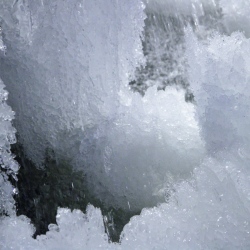
The finding, published Nature, solves a long-standing mystery about water ice in comets. Scientists already knew that the coma, the expansive cloud of gas surrounding the comet’s nucleus, is dominated by water molecules. They also knew that water ice is one of the main components of the nucleus.
Until now, traces of water ice on the surface of the comet had been difficult to detect. "First, not finding ice was a surprise; now, finding it is a surprise," said Murthy Gudipati a planetary scientist at the Jet Propulsion Laboratory in La Canada Flintridge, Calif., and an author on the paper. "It is exciting because now we are starting to understand the upper dynamic layers of the comet and how they evolved."
The surface of comet 67P, like most comets, is primarily covered by dark organic materials that appear almost black. That’s because as comets fly toward the sun, they are exposed to warm temperatures that cause volatiles like water ice on their surface to sublimate – or go directly from solid to gas.
What remains on the crust are what are known as refractory materials. These include silicates similar to rocks, sand and dirt on Earth and carbonaceous materials. Because these materials do not sublimate, the comet’s surface becomes increasingly organic and silicate rich over time, said Michael Combi, who studies comets at the University of Michigan and co-authored the paper.
The surface water ice on comet 67P Churyumov-Gerasimenko was discovered in two places several tens of feet across in a region known as Imhotep, on the bottom part of the main lobe of the comet. It was found using the VIRTIS infrared instrument, which scanned the area looking for water ice spectra signals not long after the Rosetta orbiter caught up with 67P in the fall of 2014.
In both cases the ice appeared on cliff walls and debris falls, and appeared as noticeably bright patches in visible light.
"It looked like there was a breakage, or something fell down on the surface of the comet, and a large, new inside area that had water ice was exposed," Gudipati said. "Although we knew water ice had to be in the nucleus, this was our first direct detection of that interior ice."
The small grains that are in the micrometer range are likely associated with a thin layer of frost that forms as a function of the comet’s rotation. As this region of the comet turns away from the sun, water ice condenses out of the coma and onto the nucleus, the authors wrote. During the "day" the water goes back into the coma.
The larger ice grains, which are a few millimeters across, probably have a more complex origin story, the authors said. One possibility is that water ice in the shallow subsurface of the comet might vaporize as the comet flies closer to the sun, and then move downward into the cooler lower surface lawyers where it condenses again in the voids.
"Keep in mind that comets are very porous, like cotton candy," Gudipati said. "Seventy percent of this comet is a void, and because of that, the heat from the surface does not go that deep."
It should be noted that water ice made up just a small percentage of the material scanned by VIRTIS, suggesting that it is mixed in with the refractory materials in the upper layers of the comet.
"We knew water ice made up the majority of the comet, but we didn’t know how deep or in what condition it was," he said. "This shows that it not very deep at all – perhaps just a few feet beneath the surface."
